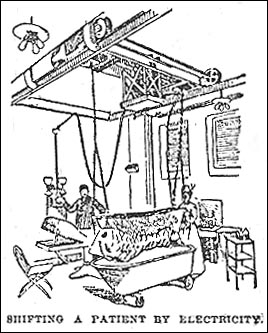View from the Lake
Heat/sun stroke was addressed in the 1800s
 I had already selected the topic of heat/sun stroke early in the week and begun writing the column. Then on Wednesday morning came the distressing news that Korey Stringer, of the Minnesota Vikings, had died during the night after collapsing on the practice field in Mankato, apparently the result of heat stroke. Heat/sun stroke has been a health problem addressed in different ways over time. In the late 1800s technology became part of the treatment.
I had already selected the topic of heat/sun stroke early in the week and begun writing the column. Then on Wednesday morning came the distressing news that Korey Stringer, of the Minnesota Vikings, had died during the night after collapsing on the practice field in Mankato, apparently the result of heat stroke. Heat/sun stroke has been a health problem addressed in different ways over time. In the late 1800s technology became part of the treatment.
In the July 9, 1895 issue of the Litchfield Independent, an article appeared discussing a scientific method to treat sunstroke victims in a New York hospital, House of Relief, on Hudson Street (former Chambers Street Hospital.) The treatment of sunstroke involved using an apparatus, "the finest in the world." Each year many people were admitted to the hospital from sunstroke and "overcomings by heat."
"There are about nine ambulance calls a day, the year around, and in the summer the number is much greater, because of the heat. A man suffering from sunstroke is almost always unconscious, and is a very difficult patient to handle. The most important remedy for sunstroke is ice and ice water, because they lower the temperature of the sufferer and drive the blood from his head."
The unique treatment offered at the hospital involved a special crane transporting a person supported in a stretcher. A visiting surgeon to the New York hospital, Dr. L. A. Stimson, was the inventor. He had the crane engineered to traverse the entire length of the sunstroke ward, a complete apartment.
"When a man suffering from the heat or the sun is brought to the hospital he is disrobed, wrapped in a sheet, and placed on a stretcher of netting. This has poles like an ordinary stretcher. The stretcher and the man are picked up by a traveling crane and lowered into a tub with 200 or 300 pounds of ice in it. The crane moves back and forth by hand, and it runs very easily. From either side of the traveler are suspended chains which part about half way down and have loops at the end, in which the poles of the stretcher are inserted. These chains are raised and lowered by an electric motor on the traveler."
The patient would lie on with the wire stretcher under him as the poles were inserted into the rings. Usually the patient was unconscious through the procedure. An attendant controlled the switch that activated the lift mechanism. The patient was smoothly and swiftly lifted into the air, rolled over the porcelain bathtub, and then lowered into the ice.
"The time he remains in this tub depends altogether upon his condition. It varies usually from fifteen minutes to half an hour. If he were in a normal condition he would be pretty nearly frozen in that time, but with a temperature of 106 or 109 as was the case with the first subjection that the apparatus was used, the ice doesn't chill very quickly. After the patient has remained in the ice water as long as the surgeon thinks necessary, he is again lifted by the electric crane, and is carried to a cot, where bags of ice water are kept under his head."
The hospital's sunstoke ward was described as a large and airy room, beautifully tiled, and finished in all white. As soon as the patient began to recover an elevator to the roof transported him so he could be exposed to fresh air. "Šhe lies under an awning in a great iron cage, which prevents him from jumping off or wandering away."
Since 1895, physicians have identified several ways to avoid sunstroke such as staying in air conditioned rooms, having fans to circulate the air, drinking plenty of fluids especially water, and limiting strenuous activities. In the summer of 2001 with many above 90-degree days and some days with the temperature and humidity combining to reach heat indexes of 110 degrees, Lake Koronis enthusiasts need to be mindful of the consequences of sunstroke to ensure their enjoyment of a view from the lake.
Contact the author at paypress@lkdllink.net • Return to Viewpoint
Home | Marketplace | Community